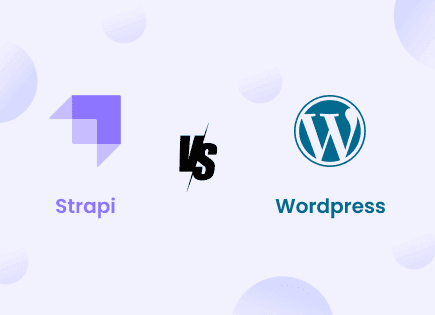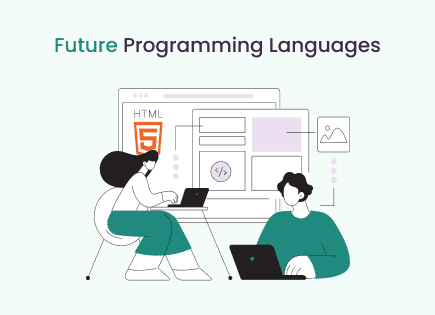Table of Content
Need to scale your logistics operations? Let our consulting experts help you build efficient, scalable solutions for your business
Get in touch
Headless CMS vs Traditional CMS: The Evolution of Content Management Systems
Table of Content
 The Internet has over a billion websites. 76 million of them deploy some form of a content management system, and about 35% of them use a Headless CMS system. So, why do so many developers prefer a headless CMS to a traditional CMS?
The Internet has over a billion websites. 76 million of them deploy some form of a content management system, and about 35% of them use a Headless CMS system. So, why do so many developers prefer a headless CMS to a traditional CMS?
Let’s find out!
Today, more people visit a business’s website rather than its physical store. Thus, websites are more important to today’s businesses than ever before.
Getting its infrastructure right is not just a challenge but an imperative.
So, is there a perfect solution to help you quickly develop and deploy highly effective websites? Yes, there is, and it’s called a content management system!
A content management system is a software or web app that helps you manage your enterprise’s digital content.
With expert CMS development services, you can quickly create, easily publish and masterfully manipulate the content on your website.
If you’ve ever heard of or used WordPress, you already know what a CMS is and how it appears. But you might not know that there are two variants of a CMS: a headless CMS and a traditional CMS.
But what separates a traditional CMS from a Headless CMS? How can you decide which one you should use?
In this blog, we’ll help you settle the traditional CMS vs headless CMS argument so you can make an informed choice about the future of your web development.
Ready to find out which CMS is right for you? Let’s dive in.
Headless CMS vs Traditional CMS : An Overview
1. Headless CMS

A headless Content Management System represents a stage of development over traditional content management systems.
In a headless CMS, the development layer and the presentation layer are separated. Simply put, it creates a separation between the front end and the back end of your content management system.
The front end consists of everything that users can see and interact with. For instance, the listings on Amazon, the “cart” functionality and the “my profile” area all refer to the front end.
On the other hand, the back end is where the magic happens. It comprises your database, the business logic, and other operational processes. In other words, Amazon's back end would be the algorithm that studies your purchases and browsing history to give you personalized suggestions and product recommendations.
Here, a Headless CMS platform separates the front and back end.
Why is this important? Imagine you want to create a mobile app for your e-commerce business. This will be difficult if you have a traditional CMS system because the current database will only cater to a traditional website.
So, if you have a headless CMS rather than a traditional one, you can create a mobile website based on the same backend functionality with minimal changes. Additionally, you can create different versions of your website with the same backend: a progressive web app, a mobile application for different operating systems and a mobile website.
Popular Headless CMS platforms include Strapi, Headless WordPress, Contentful, Prismic and others. Additionally, some CMS platforms cater to specific industries or functionalities. For instance, Spryker and Shopify cater to the e-commerce industry and provide useful services or plugins for e-commerce websites.
Let’s look at the pros and cons of a Headless CMS.
Pros of Headless CMS:
Helps build faster-loading websites
Comes with in-built SEO tools
Supports multi-lingual deployment of content
Helps craft easily scalable, future-proof websites
Enables faster upgrades and smoother maintenance
Cons of Headless CMS:
Requires you to build the design and structure of your website yourself
Increased complexity and technical requirements for backend development
Needs additional technology for presentation and delivery
Here are some real-life use cases of Headless CMS:
Google has partnered with commerce tools to offer its users a cloud business platform
Companies like Aldi and Daimler use Spryker to power their online stores,
Coursera and GoDaddy use Contentful to provide their customers with immersive experiences,
FIGS and Bpifrance use Strapi to create highly responsive websites for their users,
Cognizant and CredAvenue harness Sanity to render their websites for thousands of customers.
You May Also Like: Strapi vs Sanity
2. Traditional CMS

Traditional CMS, on the other hand, is a monolithic approach to web development.
It deals with the front and back end as a single compact block of information. So, where a decoupled or headless CMS separates the design and delivery layer from the database and code layer, the traditional CMS doesn’t make this separation.
The most important implication is that changes to the back end can and do affect the front end and vice versa.
Popular examples of traditional CMS platforms include Wix, Squarespace and WordPress. So, if headless or decoupled CMSs are the future, why are traditional CMS platforms still around? Let’s find out:
Pros of Traditional CMS:
Easy to understand, ideal for content-based websites
Comes with templates for themes, colors and presentation layers
Users can completely customize the front ends of their websites
Quick initial development: easy to set up and deploy
Requires lower financial commitment
Cons of Traditional CMS:
In-house hosting leads to higher storage and maintenance costs
Difficult to scale websites or develop new ones based on the same databases
Slower loading speeds due to higher plug-in dependency.
Popular companies and brands like BBC America, Microsoft, Etsy and Facebook still use traditional CMS to power their websites.
Now that we understand the basics of traditional vs headless CMS, let’s find out what differentiates them.
The Debate: Headless CMS vs Traditional CMS
Point of Difference | Headless | Traditional |
Architecture | Polylithic: Separates the Front End from the Back End | Monolithic: the Front and Back End Function Together |
Purpose | For Dynamic, Agile Websites that Require Regular Updates | Static or Content-Only Websites That Require Limited Updates |
Ease of Use | Very Easy to Create, Deploy and Manipulate Content | Harder to Develop, Deploy and Manipulate Content |
Development Flexibility | Smooth Development Process: New Features Can Be Deployed Quickly | Rigid Development Process: New Features Require Time to Develop and Deploy |
Development Speed | Slower Initial Development But Agile Process Once Established | Faster Initial Development But Complicated Later Development Process |
1. Architecture
As we have seen, traditional CMS has a monolithic architecture. It combines the front end and the back end under one system.
On the other hand, a headless CMS is a faster content creation and delivery system. It relies on webhooks and plug-ins to display content and information to the viewers.
2. Purpose
For some developers, headless vs traditional CMS is not usually a debate worth getting into. Why? Because their purpose is clear.
So, if you’re a content-publishing website or need a static website based on functionality rather than user experience, traditional CMS would do just fine.
On the other, say you’re an e-commerce company. You’ll need to scale your website in terms of its content and user traffic. Moreover, you might also have to create more websites or mobile apps depending on the market you want to enter. In such cases, a headless CMS system is the best for you.
3. Ease of Use
Insofar as ease of use is concerned, we must account for two stakeholders: the content creator and the website developer.
For the content creator, headless CMS is the obvious choice. They can create and publish content, collaborate with others and manipulate the content as they wish without technical background or the risk of affecting the backend.
On the other hand, for developers, it is a question of expertise and the time available. While initial development and deployment are simpler through traditional CMS, Headless CMS offers a much broader development trajectory.
4. Development Flexibility
This brings us to our next point of differentiation: the development flexibility each platform offers. Given the decoupling of the front and back end, headless CMS offers better functionality for long-term development.
Using a headless CMS, you can create multiple websites for different devices and regions using the same database.
This is not true of traditional CMSs. Thus, using traditional CMSs limits your long-term development plans.
5. Development Speed
Development speed represents another interesting trade-off in the debate of headless CMS vs traditional CMS.
This is because while traditional CMS speeds up development in the initial stages, Headless CMS speeds up development in the long term.
For instance, you can use Headless infrastructure to quickly deploy features like AI-powered chatbots, the latest payment interfaces or generative itinerary builders.
It is more difficult to introduce such functionalities through a traditional CMS.
So, Which CMS Is Best For Your Project?
So, why is the rise of Headless Content Management Systems relevant? Because the future is bound to be headless. While it requires technical expertise for development, it also offers a wider scope of long-term development.
Here are the four major reasons why Headless CMS should form the pillar of your web development strategy.
1. The Rise of Omni Channel Experiences
In the information age, reaching new customers is easier than ever. They are more accessible everywhere: through smart TVs that collect ad data, wearables that collect movement data or smartphones that collect user data.
However, this data also requires developers to react quickly and introduce new experiences to avoid losing customers.
And off headless vs traditional CMS, only the former provides this ability for iterative development.
2. You Want to Offer Iterative Experience
This brings us to another change dominating contemporary marketing efforts: the Agile approach. According to this doctrine, developers and enterprises must be able to quickly read and understand which way the wind is blowing.
But this is not enough: they must also react to the changing wind direction and adapt their customer experiences.
The rise of AI is an example of these iterative experiences. First, all major mobile companies have advertised their latest smartphones because they come with a proprietary AI assistant. Second, all apps are introducing AI-powered features, including chatbots, itinerary builders, image generators and more.
Thus, offering iterative experiences has become imperative in today’s market conditions. Again, Headless CMS offers a much wider array of functionalities and ease of development compared to traditional CMS.
3. CX is Central to Your Growth
Today, we’re in the midst of a marketing transformation. Customer experience is fast replacing funnel marketing as the all-encompassing strategy. Customer experience focuses on collecting a variety of consumer data related to all parts of a customer’s journey.
It also replaces the focus on funnel-centric marketing with experience-centric marketing. Thus, CX requires enterprises to introduce dynamic, changing customer experiences and hyper-personalization based on a wide range of user data.
So, if CX is central to your industry (travel, logistics, e-commerce, education or healthcare), Headless CMS is the future. It can help you collect important consumer data, create user profiles and make rapid changes to the front-end of your websites.
4. Enterprise-Level Security is a Priority
Lastly, if you’re concerned about sensitive business data, Headless CMS offers you a range of tools to secure corporate information from prying eyes. It helps you assign user roles and permissions based on specific documents, website layers and data types.
Thus, Headless CMS helps you achieve granular control and security over corporate information.
Ready to Find Your Perfect CMS Solution?
Book your demo with our expert developers today.
Schedule a Call
Conclusion
We have seen that in the debate between headless CMS vs traditional CMS, headless CMS is the future-proof tool for web development.
Headless CMS allows non-technical users to manipulate information and collaborate with others while also empowering developers to create and introduce complex technical features to enhance user experiences.
Thus, we believe that Headless CMS gives you a considerable advantage in creating cutting-edge, highly responsive websites for your users and employees alike.
At Green Apex, we provide bespoke Headless CMS development services to help you create seamless websites with smooth front-ends and sophisticated back-ends.
So, if you’re wondering which CMS platform is right for you or how you can deploy effective websites, look no further!
Reach out to our custom CMS development team and let us help you reach the pinnacle of your industry through an ultramodern online architecture.
FAQs
In the debate between traditional CMS vs headless CMS, the main difference is that a headless CMS offers users a separation between the front and the back end of their content management system. Thus, users can change the front end without affecting the back end and vice versa. This means headless CMS is very attractive for users who want to manipulate the front end but lack a technical background.
The separation between headless CMS's front and back ends makes it faster than traditional CMS. This is because, in a normal CMS system, a developer has to ensure that changes to the back end are completely compatible with the front end and vice versa. With a Headless CMS, on the other hand, you can create a back end that is compatible with multiple front end platforms.
The three benefits of using Headless CMS include ease of use for non-technical users, fast development pace and the ability to develop a multi-platform back end that can be deployed for different front-end platforms and devices.
At Green Apex, we provide headless CMS development services through an industry-centric approach. We help enterprises create a robust backend using highly compatible frameworks and languages such that they can integrate their content with any front end. Thus, we help enterprises create future-proof development infrastructure through Headless CMS.
At Green Apex, we specialize in working with various Headless platforms, including Strapi, Prismic, Contentful, Kontent.ai and. We can also help you develop your website or integrate your existing infrastructure with various industry-specific content management systems.
Related Blogs

The Ultimate Travel App Development Guide: Features, Cost, and Development Process
The travel business is changing. Before people traveled physically to their desired destinations, but now ...

Strapi vs WordPress Headless: Which CMS is Best for Your Project?
Making a website may feel daunting, but CMS (content management system) makes it a lot easier. ...

Top 17 Future Programming Languages 2025-2030
Over the past decade, our computing capabilities have improved radically and coding languages have evolved at ...















